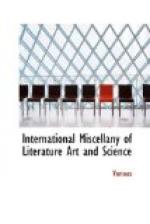A good life of Chantrey would be a welcome and a serviceable contribution to the general store. Chantrey was a national sculptor in the sense that Burns was a national poet. His genius, of the highest order, indicated throughout his career the nature of the soil in which it had been cherished. As man and artist he was essentially British. By his own unassisted strength he rose from the ranks, and achieved the highest eminence by the simplest and most legitimate means. His triumph is at once a proof of his power, and an answer to all who, instead of putting shoulder to the wheel, console their mediocrity by railing against the cold exclusiveness of aristocratic institutions.
Chantrey began life in a workshop. A friend, toward the close of the artist’s life, passing through his studio, was struck by a head of Milton’s Satan lying in a corner. “That head,” said Chantrey to his visitor, “was the very first thing that I did after I came to London. I worked at it in a garret, with a paper cap on my head, and, as I could then afford only one candle, I stuck that one in my cap that it might move along with me, and give me light whichever way I turned.” A still severer school of discipline had, previously to his appearance in the London garret, given his mind the practical turn chiefly characteristic of his life and works. He was born in 1782, at Norton, in Derbyshire, and when eight years old lost his father. His mother married again, and in 1798 proposed to apprentice him to a solicitor in Sheffield. Whilst walking through that town the boy saw some wood carving in a shop window. His good angel was with him at the moment, and stood his friend. Chantrey begged to be made a carver, and he was accordingly apprenticed to a Mr. Ramsay, a wood carver in Sheffield.
At the house of his master the apprentice often met Mr. Raphael Smith, known for his admirable crayon drawings. The acquaintance led to a more refined appreciation of art, and excited in the youth so strong a desire to cultivate it in a higher sphere, that at the age of 21 he gave to his master the whole of his wealth, amounting to L50, to cancel his indentures. Had he waited patiently for six months longer, his liberty would have been his own, unbought. Leaving the carver’s shop Chantrey began to study in earnest. He painted a few portraits, which brought him in a little money, and, with a little more borrowed from his friends, he started for London. Here, guided by common sense, he sought employment as an assistant carver. He might have starved had he started as a professional painter.
Whilst laboring for subsistence Chantrey still used his brush, and also laid the foundation of his coming success by making models in clay of the human figure. He would hang, says his present biographer, pieces of drapery on these models, “that he might get a perfect knowledge of the way, and the best way, that it should be represented. In this manner he was accustomed to work, and when he had completed one figure or mass of drapery he pulled it down and began to model another from drapery differently arranged; for at that time he never did anything without nature or the material being before him.” In 1808 Chantrey’s first imaginative work was exhibited. We have already mentioned it. It was the head of Satan produced in the garret.




